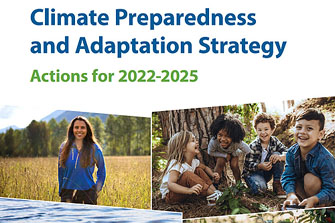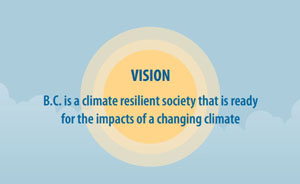Monday June 20, 2022 | VICTORIA, BC
by Mary P Brooke | Island Social Trends
The new Climate Preparedness and Adaptation Strategy is intended to help people in British Columbia be better protected from the impacts of wildfires, flooding and extreme heat through the actions.
The strategy during 2022-2025 includes actions across ministries supported by $513 million of investment to ensure British Columbia is prepared for climate impacts in the near term, while setting the foundation for future action.
The strategy is part of a broader suite of investments from Budget 2022 totalling more than $2.1 billion allocated to support people and communities recover from recent disasters and prepare for future climate impacts.
Last year’s extreme weather:
“Last year’s extreme weather left no doubt that British Columbia is directly experiencing impacts of the climate crisis,” said George Heyman, Minister of Environment and Climate Change Strategy.
“We’re making record investments to recover from last year’s extreme floods and fires and adapt to future climate changes, as well as working to cut climate pollution through our CleanBC plan.”
“We’re committed for the long-term,” says Heyman. “This new strategy takes targeted action now to support food security and resilient local agriculture, create better floodplain risk mapping to improve how we plan our communities, support more cultural and prescribed burning in partnership with Indigenous Peoples, and build more resilient highways and infrastructure so they can withstand future climate impacts.”
Wildfire, flood, heat and droughts:
The strategy outlines a range of government actions to help people and communities prepare including:
- an expanded role for the BC Wildfire Service to provide enhanced wildfire prevention and preparedness;
- the development of a comprehensive provincial flood strategy and flood resilience plan to ensure communities are better protected from extreme flooding;
- an extreme heat preparedness plan to help people and communities stay safe during heat waves and extreme heat emergencies; and
- investments in nature-based solutions that will reduce the impacts of flooding and droughts by restoring healthy watersheds.
On June 8, the province announced their Heat Alert and Response System (HARS) which will use the Alert Ready system as well as a $189-million Community Emergency Preparedness Fund for extreme heat-risk mapping, assessment and planning by local governments and Indigenous communities.
FireSmart practices are helping:
The strategy also includes investments for First Nations and local governments to increase wildfire protection through community-led FireSmart activities. Last summer, the town of Logan Lake successfully fought back the threat of wildfire at its municipal borders, thanks to the work of local firefighters and years of implementing FireSmart practices.
“Restoring the health of Kus-kus-sum watershed on K’omoks territory is critically important to live in balance with nature and prepare for the impacts of climate change, like extreme flooding and drought,” said Hegus Nicole Rempel, K’omoks First Nation.
“K’omoks First Nation is working with local partners to turn a former sawmill site into critical habitat for salmon, herring, migratory birds and other species. By removing cement, regrading natural slope and adding native plants to the area, we’re healing vital ecosystems and building greater resiliency to climate change.”
“Climate change has already had significant impacts on communities like Logan Lake through increased wildfires. As our efforts have shown, investing in FireSmart and preparing for wildfires ahead of time is extremely valuable and effective at reducing impacts to communities,” said Robin Smith, mayor, Logan Lake. “The new provincial adaptation strategy includes increased supports through FireSmart to help more local governments reduce the risks of wildfires and protect the places we call home.”
Here on Vancouver Island, some communities are making a concerted effort to focus on wildfire and other emergency management preparations this summer, including the District of Metchosin which has primarily rural properties and where they recommend following the BC Government’s Landscaping Hub FireSmart Guide.
Transportation resiliency:

The resiliency of B.C.’s highway network will result through a nearly $300-million investment over nine years to replace and rehabilitate existing culverts so they will be able to handle extreme weather events.
Here on Vancouver Island the Malahat stretch of Highway 1 (a corridor essential for travel between the south and north parts of the island) was washed out due to flooding in mid-November 2021. Immediate repairs got underway right away, and more is being done this summer.
Across the province, the work includes upsizing culverts, redesigning drainage channels for future flow and reinforcing of slopes that will see greater saturation in the future.
Wide range of input:
The Province developed the strategy based on a wide range of input, including significant feedback through two working groups and multiple engagements with Indigenous Peoples and organizations. Additional input came from the general public, local governments, academics, businesses, non-profits, youth and others.
CleanBC Roadmap to 2020:
The Climate Preparedness and Adaptation Strategy is part of the CleanBC Roadmap to 2030.
The roadmap is the Province’s plan to expand and accelerate climate action by building on B.C.’s natural advantages – abundant and clean electricity, innovative technology and a highly skilled workforce. It sets a path for increased collaboration to build a British Columbia that works for everyone.
Budget 2022 committed more than $1.2 billion to support the CleanBC Roadmap to 2030, which builds on $2.3 billion in prior CleanBC investments, in order to expand and accelerate actions that will reduce climate pollution and build a cleaner, stronger economy.
===== GOVERNMENT LINKS:
Full Climate Preparedness and Adaptation Strategy (PDF download)
CleanBC and the Roadmap to 2030
===== RELATED:
BC launches preparedness plan for heat events (June 8, 2022)
BC Coroners report on extreme heat deaths dedicated to the victims (June 7, 2022)
Meteorologist tells UBCM: heat dome was no surprise (September 15, 2021)









